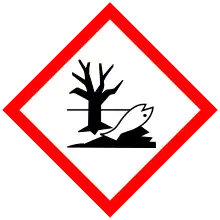| Names | |
|---|---|
| Preferred IUPAC name
Dodecanal | |
| Other names
Lauraldehyde; Dodecyl aldehyde | |
| Identifiers | |
3D model (JSmol) |
|
| ChEBI | |
| ChemSpider | |
| ECHA InfoCard | 100.003.621 |
PubChem CID |
|
| UNII | |
CompTox Dashboard (EPA) |
|
| |
| |
| Properties | |
| C12H24O | |
| Molar mass | 184.323 g·mol−1 |
| Appearance | Colorless liquid[1] |
| Density | 0.83 g cm−3[1] |
| Melting point | 12 °C (54 °F; 285 K)[1] |
| Boiling point | 257 °C (495 °F; 530 K)[1] |
| Hazards | |
| GHS labelling:[1] | |
  | |
| Warning | |
| H315, H411 | |
| P273, P302+P352 | |
| Flash point | 114 °C (237 °F; 387 K)[1] |
| Related compounds | |
Related |
|
Except where otherwise noted, data are given for materials in their standard state (at 25 °C [77 °F], 100 kPa).
Infobox references | |
Dodecanal, also known as lauraldehyde or dodecyl aldehyde, is an organic compound with the chemical formula CH3(CH2)10CHO. This colourless liquid is a component of many fragrances. It occurs naturally in citrus oils, but commercial samples are usually produced from dodecanol by dehydrogenation.[2]
References
- 1 2 3 4 5 6 Record of dodecanal in the GESTIS Substance Database of the Institute for Occupational Safety and Health
- ↑ Christian Kohlpaintner; Markus Schulte; Jürgen Falbe; Peter Lappe; Jürgen Weber. "Aldehydes, Aliphatic". Ullmann's Encyclopedia of Industrial Chemistry. Weinheim: Wiley-VCH. doi:10.1002/14356007.a01_321.pub2. ISBN 978-3527306732.
This article is issued from Wikipedia. The text is licensed under Creative Commons - Attribution - Sharealike. Additional terms may apply for the media files.